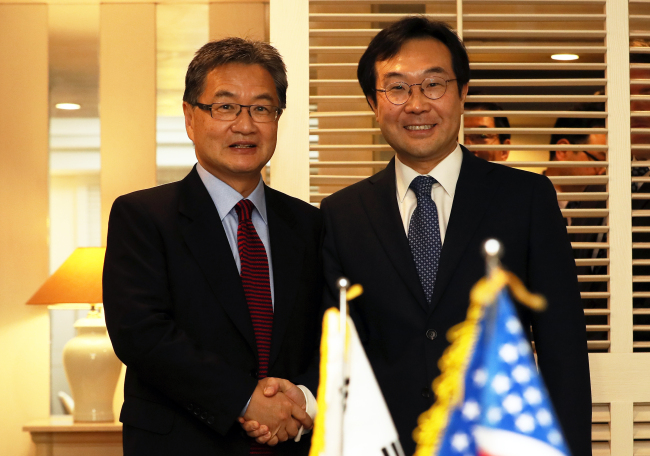S. Korea, US stress diplomatic solution for NK nuclear issue
By Jung Min-kyungPublished : Nov. 17, 2017 - 16:08
The top nuclear envoys of South Korea and the United States on Friday upheld bilateral cooperation in forging a path for a diplomatic solution to bring North Korea to dialogue. The two also said Pyongyang needs to show a “clearer sign” of willingness to talk.

Lee Do-hoon, South Korea’s special representative for Korean Peninsula peace and security affairs, held a meeting with his US counterpart Joseph Yun to discuss security issues surrounding the Korean Peninsula and ongoing threats from the North’s fast-growing weapons program. The meeting was held on Jeju Island.
“There is no doubt that both of the presidents want to find a peaceful way in regard to North Korea’s nuclear issue. So we discussed them and agreed the pressure campaign has to be a core element,” Yun told reporters after the meeting.
Yun’s visit follows the end of US President Donald Trump’s 12-day tour of Asian nations earlier this week, which included a summit with President Moon Jae-in here.
Yun also mentioned the international community’s implementation of sanctions and pressure on the North as a crucial step toward denuclearization.
“We have been engaged with countries like China, Russia, as well as Japan and the EU, aimed at getting pressure on North Korea to have a meaningful and credible dialogue with us so that they can take steps towards the denuclearization,” he said. “We very much agree on that, and again today we reaffirmed that goal.”
The meeting also came amid nearly two months without Pyongyang’s provocations, with a missile launch on Sept. 15 being the most recent. Yun told the Council on Foreign Relations on Oct. 30 that if North Korea stopped nuclear and missile testing for about 60 days, it would be a signal the US should resume direct talks with Pyongyang.
But the two nuclear envoys stated Pyongyang’s current intention is too ambiguous to interpret the pause in provocations as a positive sign for talks.
“I hope that they will stop forever. But we had no communication from them so I don’t know whether to interpret it positively or not. We have no signal from them,” Yun said.
In line with Yun’s remarks, Lee said the “60-day clock” had not started yet on Pyongyang’s lack of explanation of the hiatus.
Yun said Tuesday that he did not know why the North had halted its provocations, but urged the North to refrain from provocations “for a period of time,” adding that it would be a “good start.”
Although the US has hinted at willingness to establish more direct lines of communication with the North, it has also cited denuclearization as an essential precondition for dialogue.
North Korea has displayed its defiance of such requests through statements and military provocations. The latest message came Friday through its official mouthpiece in a commentary titled, “(The US) Should Abandon Stupid Ambition.”
“The conclusion that our army and people have reached via the history of North Korea-US confrontations is there is no way other than standing against the repressive US imperialists only with a nuclear deterrent of justice,” said Rodong Sinmun, a daily of the North’s ruling Workers’ Party.
“We’ve already made clear that we would never take even one step back from a road to beefing up national nuclear power unless the US hostile policy against us comes to an end.”
North Korean Foreign Minister Ri Yong-ho had previously stated the major goal of its weapons program was to achieve a “balance of power” with the US.
On the weapons program, top officials in both South Korea and the US, including Seoul’s Foreign Minister Kang Kyung-wha, have acknowledged that it has reached a stage of “near-completion,” but South Korea’s spy agency claimed it still has a large obstacle to overcome.
“(The NIS said that) the North had recently carried out a few missile engine tests, but it is still not at a stage where it can complete its ICBM development,” an unnamed parliamentary source told Yonhap News Agency on Friday, referring to the North’s lack of atmospheric re-entry technology. An NIS official made the reports during a session of the National Assembly‘s Intelligence Committee on Thursday, the source said.
Securing such ability will allow Pyongyang to build a missile that can withstand the heat-intensive process of re-entering the Earth’s atmosphere.
It is widely believed that Pyongyang has been grappling to secure the technology, despite its claimed success through previous liftoffs of its Hwasong-14 intercontinental ballistic missiles.
However, this does not indicate that North Korea is ready to abandon its decadeslong nuclear ambition, as reports on testing of relevant key technologies continue to surface.
The North is on an “aggressive schedule” to build and deploy its first operational ballistic missile submarine, a recent analysis by 38 North said, pointing to busy movements of parts and components detected near its key shipyard.
Citing military sources, Japan’s Asahi Shimbun daily reported on Nov. 12 that Pyongyang has conducted a series of combustion experiments for a new solid-fueled missile engine. It may have been for an upgraded version of its ground-to-ground medium-to-long-range Pukguksong-2 ballistic missile or new submarine-launched ballistic missiles.
By Jung Min-kyung (mkjung@heraldcorp.com)








![[KH Explains] How should Korea adjust its trade defenses against Chinese EVs?](http://res.heraldm.com/phpwas/restmb_idxmake.php?idx=644&simg=/content/image/2024/04/15/20240415050562_0.jpg&u=20240415144419)











![[Today’s K-pop] Stray Kids to return soon: report](http://res.heraldm.com/phpwas/restmb_idxmake.php?idx=642&simg=/content/image/2024/04/16/20240416050713_0.jpg&u=)